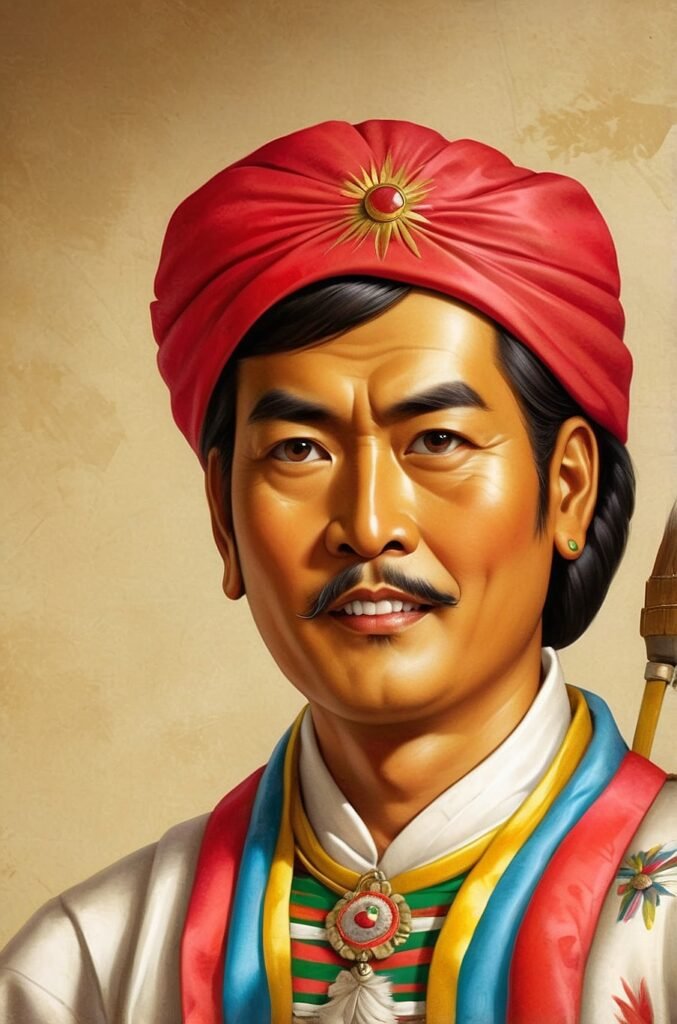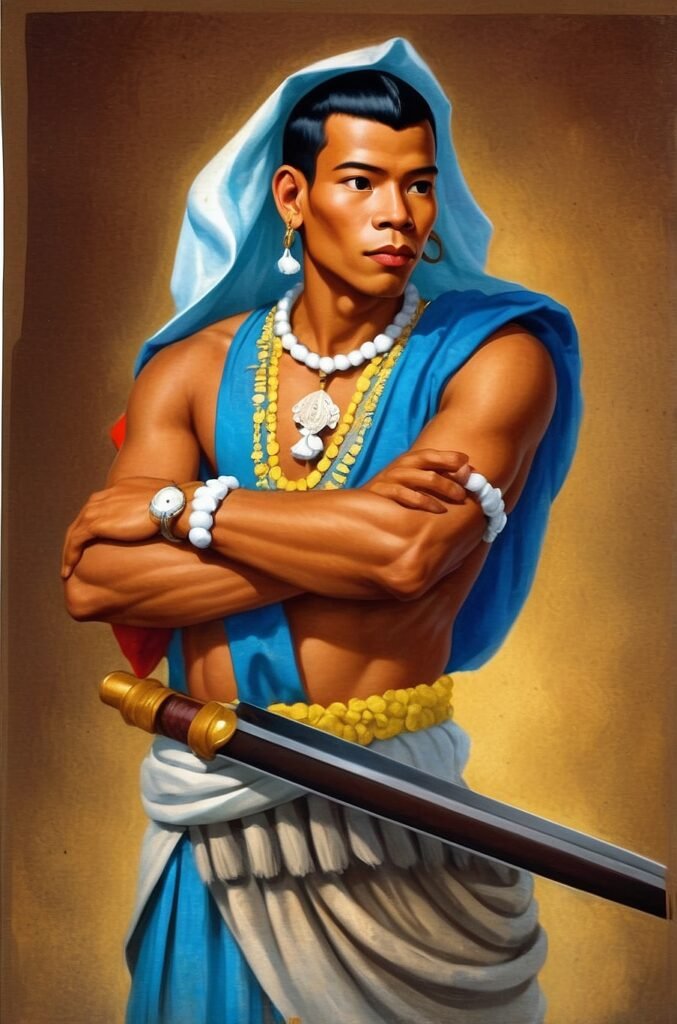In the annals of Philippine history, few events hold as much symbolic significance as the Blood Compact of 1565 between Datu Sikatuna, a local chieftain from Bohol, and Miguel López de Legazpi, the Spanish explorer. This momentous occasion marked the first treaty of friendship between the Philippines and Spain, setting the stage for centuries of cultural exchange and historical intertwining. This blog post delves into the life of Datu Sikatuna, the context of the Blood Compact, and its lasting impact on Philippine history and culture.
The Life of Datu Sikatuna
Early Life and Rise to Power
While historical records about Datu Sikatuna’s early life are scarce, we know that he was born in the early 16th century on the island of Bohol, in the central Philippines. Sikatuna belonged to the ruling class of pre-colonial Filipino society, known as the datu. This class was composed of noble warriors who governed their respective territories and commanded respect from their subjects.
Sikatuna’s ascent to power likely followed the traditional path of succession within the datu system. This system was based on a combination of hereditary rights and personal merit, with leadership often passing from father to son or to the most capable male relative. Sikatuna would have been groomed from a young age to take on the responsibilities of leadership, learning the intricacies of governance, warfare, and diplomacy.
Governance and Territory
As a datu, Sikatuna ruled over a significant portion of Bohol, centered around the area now known as Tagbilaran City. His domain would have included several barangays or villages, each with its own local leaders who answered to him. The exact extent of his territory is not precisely known, but it likely encompassed a substantial part of southern Bohol.
Datu Sikatuna’s governance would have been characterized by:
- Maintaining peace and order within his territory
- Settling disputes among his subjects
- Leading his people in times of war
- Overseeing trade with neighboring regions
- Conducting diplomatic relations with other datus and foreign visitors
The Historical Context of the Blood Compact
The Spanish Expedition
To understand the significance of the Blood Compact, we must first examine the context of the Spanish expedition to the Philippines. In 1564, King Philip II of Spain commissioned Miguel López de Legazpi to lead an expedition to the East Indies. The primary objectives of this mission were to:
- Establish a Spanish presence in the region
- Spread Christianity
- Secure a share of the lucrative spice trade
Legazpi’s fleet departed from Mexico on November 21, 1564, and after a journey of several months, arrived in the Philippines in early 1565.
First Encounters
Upon reaching the Philippine archipelago, Legazpi and his men had several encounters with local inhabitants. Some of these interactions were peaceful, while others were marked by hostility and suspicion. The Spaniards were eager to establish friendly relations with local leaders to facilitate their colonization efforts and to secure provisions for their journey.
The Importance of Alliances
For the Spanish, forming alliances with local chieftains was crucial for several reasons:
- It provided legitimacy to their presence in the islands
- It ensured access to food and other resources
- It offered protection against potentially hostile groups
- It facilitated the spread of Christianity and Spanish influence
For local leaders like Datu Sikatuna, alliances with the powerful newcomers could offer:
- Protection against rival chieftains
- Access to new trade opportunities
- Potential military support in local conflicts
- A chance to maintain some degree of autonomy under Spanish rule
The Blood Compact of 1565
The Meeting of Two Leaders
On March 16, 1565, Legazpi’s fleet anchored off the coast of Bohol. Datu Sikatuna, known for his diplomatic skills and openness to foreign traders, sent emissaries to the Spanish ships to establish contact. Impressed by this gesture of goodwill, Legazpi arranged to meet with the Boholano chieftain.
The Ceremony
The Blood Compact, known in Spanish as “Pacto de Sangre” and in Filipino as “Sandugo,” took place on March 16, 1565. The ceremony followed these steps:
- Datu Sikatuna and Miguel López de Legazpi each made a small cut on their arms.
- They collected a few drops of blood from their wounds.
- The blood was mixed with wine in two separate cups.
- Each leader drank from the cup containing the other’s blood.
This ritual, common in many cultures throughout history, symbolized a bond of friendship and trust between the two parties. It was a solemn oath of alliance, marking the participants as blood brothers.
Significance of the Blood Compact
The Blood Compact between Datu Sikatuna and Legazpi was significant for several reasons:
- It was the first recorded treaty between the Philippines and a European power.
- It established a precedent for peaceful negotiations between Filipinos and Spaniards.
- It facilitated the initial Spanish settlement in the Philippines.
- It symbolized the beginning of over three centuries of Spanish colonial rule in the Philippines.
Impact on Philippine History
Short-term Effects
In the immediate aftermath of the Blood Compact, several developments occurred:
- Legazpi was able to establish a base on Bohol, where his men could rest and replenish their supplies.
- The alliance with Datu Sikatuna provided the Spanish with valuable information about the local political landscape and resources.
- Other local chieftains, seeing Sikatuna’s acceptance of the Spanish, became more open to negotiations.
Long-term Consequences
The Blood Compact had far-reaching consequences for Philippine history:
- It paved the way for the Spanish colonization of the Philippines, which would last until 1898.
- It began a process of cultural exchange and intermixing between Filipino and Spanish cultures.
- It led to the gradual transformation of the Philippines’ political, social, and religious structures.
- It became a symbol of Filipino diplomacy and willingness to engage with foreign powers.
Datu Sikatuna in Philippine Culture
Commemorations and Honors
Datu Sikatuna’s role in Philippine history has been commemorated in various ways:
- The Order of Sikatuna, one of the highest honors bestowed by the Philippine government, was established in 1953.
- A monument depicting the Blood Compact stands in Tagbilaran City, Bohol.
- Several schools and streets throughout the Philippines bear Sikatuna’s name.
Artistic Representations
The Blood Compact has been a popular subject in Philippine art:
- Juan Luna’s painting “The Blood Compact” (1886) is one of the most famous depictions of the event.
- Numerous contemporary artists have created their interpretations of the historic meeting.
- The event has been portrayed in various films and television shows about Philippine history.
Historical Debates and Interpretations
Differing Perspectives
While the Blood Compact is generally viewed positively in Philippine history, some scholars have raised questions about its interpretation:
- Some argue that the significance of the event has been exaggerated by later historians.
- Others question whether Sikatuna fully understood the implications of the alliance with Spain.
- There are debates about the exact location and details of the ceremony.
Table: Contrasting Views on the Blood Compact
| Perspective | View on the Blood Compact |
|---|---|
| Traditional | A symbol of Filipino hospitality and diplomacy |
| Critical | The beginning of colonial subjugation |
| Revisionist | A pragmatic political alliance |
| Nationalist | A testament to pre-colonial Filipino statecraft |
Legacy of Datu Sikatuna
In Bohol
Datu Sikatuna’s legacy is particularly strong in his home province of Bohol:
- He is considered a local hero and a symbol of Boholano identity.
- The Blood Compact site is a major tourist attraction in Tagbilaran City.
- Annual festivals and events commemorate the historic meeting with Legazpi.
In National History
On a broader scale, Datu Sikatuna’s legacy includes:
- Recognition as one of the earliest Filipino leaders to engage in international diplomacy.
- A symbol of the complex relationships between indigenous leaders and colonial powers.
- A reminder of the rich cultural and political traditions that existed in the Philippines before Spanish colonization.
Lessons for Modern Diplomacy
Principles of the Blood Compact
The Blood Compact embodied several principles that remain relevant in modern international relations:
- The importance of personal relationships in diplomacy
- The value of symbolic gestures in building trust
- The need for mutual respect between different cultures
- The potential for peaceful negotiation even in the face of power imbalances
Contemporary Applications
While the context has changed dramatically since 1565, some aspects of the Blood Compact’s spirit can be seen in modern diplomatic practices:
- State visits and personal meetings between leaders
- The use of cultural exchanges to build international goodwill
- The emphasis on finding common ground in negotiations
- The recognition of local and indigenous leaders in international forums
Conclusion
Datu Sikatuna, the Boholano chieftain who entered into a Blood Compact with Miguel López de Legazpi in 1565, occupies a unique place in Philippine history. His actions, whether viewed as a demonstration of Filipino hospitality or as a pragmatic political move, had far-reaching consequences for the Philippines. The Blood Compact marked the beginning of centuries of Spanish influence in the archipelago, shaping the nation’s culture, religion, and political structures in profound ways.
Today, Datu Sikatuna is remembered not just as a historical figure, but as a symbol of Filipino diplomacy and openness to the world. His legacy reminds us of the complex interplay between local traditions and global forces that has characterized much of Philippine history. As we continue to navigate an increasingly interconnected world, the story of Datu Sikatuna and the Blood Compact offers valuable lessons about the power of personal diplomacy, the importance of cultural understanding, and the enduring impact of symbolic gestures.
Whether viewed through the lens of colonial history, indigenous rights, or international relations, the Blood Compact of 1565 remains a pivotal moment in Philippine history. It continues to inspire discussion, debate, and artistic expression, ensuring that the name of Datu Sikatuna will be remembered for generations to come.
Disclaimer: This blog post is based on historical records and scholarly interpretations available at the time of writing. While every effort has been made to ensure accuracy, our understanding of historical events can change as new evidence comes to light. Readers are encouraged to consult additional sources for the most up-to-date information. If you notice any inaccuracies in this post, please report them so we can correct them promptly.




